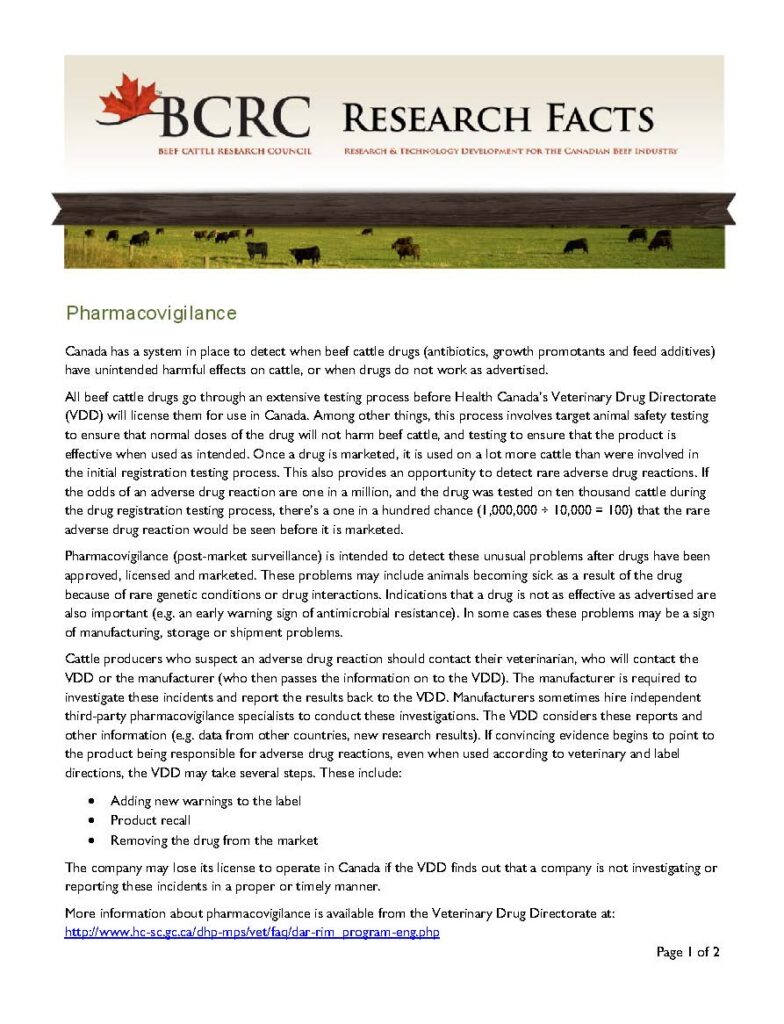Pharmacovigilance
Canada has a system in place to detect when beef cattle drugs (antibiotics, growth promotants and feed additives) have unintended harmful effects on cattle, or when drugs do not work as advertised.
All beef cattle drugs go through an extensive testing process before Health Canada’s Veterinary Drug Directorate (VDD) will license them for use in Canada. Among other things, this process involves target animal safety testing to ensure that normal doses of the drug will not harm beef cattle, and testing to ensure that the product is effective when used as intended. Once a drug is marketed, it is used on a lot more cattle than were involved in the initial registration testing process. This also provides an opportunity to detect rare adverse drug reactions. If the odds of an adverse drug reaction are one in a million, and the drug was tested on ten thousand cattle during the drug registration testing process, there’s a one in a hundred chance (1,000,000 ÷ 10,000 = 100) that the rare adverse drug reaction would be seen before it is marketed.

Pharmacovigilance (post-market surveillance) is intended to detect these unusual problems after drugs have been approved, licensed and marketed. These problems may include animals becoming sick as a result of the drug because of rare genetic conditions or drug interactions. Indications that a drug is not as effective as advertised are also important (e.g. an early warning sign of antimicrobial resistance). In some cases these problems may be a sign of manufacturing, storage or shipment problems.
Cattle producers who suspect an adverse drug reaction should contact their veterinarian, who will contact the VDD or the manufacturer (who then passes the information on to the VDD). The manufacturer is required to investigate these incidents and report the results back to the VDD. Manufacturers sometimes hire independent third-party pharmacovigilance specialists to conduct these investigations. The VDD considers these reports and other information (e.g. data from other countries, new research results). If convincing evidence begins to point to the product being responsible for adverse drug reactions, even when used according to veterinary and label directions, the VDD may take several steps. These include:
- Adding new warnings to the label
- Product recall
- Removing the drug from the market
The company may lose its license to operate in Canada if the VDD finds out that a company is not investigating or reporting these incidents in a proper or timely manner.
More information about pharmacovigilance is available from the Veterinary Drug Directorate.
Learn more
Canada’s veterinary drug approval process
BCRC Blog | November 21, 2013
Q&A on conventional production of Canadian beef
BCRC Blog | September 26, 2013
Click here to subscribe to the BCRC Blog and receive email notifications when new content is posted.
The sharing or reprinting of this BCRC Blog article is welcome and encouraged. Please provide acknowledgement to the Beef Cattle Research Council, list the website address, www.BeefResearch.ca, and let us know you chose to share the article by emailing us at [email protected].
We welcome your questions, comments and suggestions. Contact us directly or generate public discussion by posting your thoughts below.